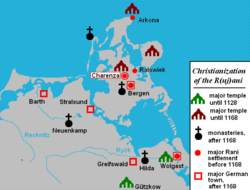
Back Ránové Czech Ranen German Ranes French Rani ID Rani (popolo) Italian ラーン人 Japanese Ranowie Polish Ranes Portuguese Руяне Russian Rujani Serbo-Croatian
| 9th century–1168 | |||||||||||
 Christianization of the Rani; Slavic settlements, German towns with pagan temples and Christian monasteries | |||||||||||
| Status | Slavic tribe of the Lutician federation | ||||||||||
| Capital | Arkona (seat of pagan high priests, political and religious centre) Charenza (princely seat and formal capital) | ||||||||||
| Common languages | West Lechitic (Rani) | ||||||||||
| Religion | Polabian Slavic paganism, the known cults:
| ||||||||||
| Government | de facto pagan theocracy, formally hereditary monarchy (principality) | ||||||||||
| Prince | |||||||||||
• c. 955 (first) | Vitzlav | ||||||||||
• c. 1170 (last) | Jaromar I | ||||||||||
| History | |||||||||||
• Formed | 9th century | ||||||||||
| 1168 | |||||||||||
| |||||||||||
| Today part of | Germany | ||||||||||
The Rani or Rujani (German: Ranen, Rujanen) were a West Slavic tribe based on the island of Rugia (Rügen) and the southwestern mainland across the Strelasund in what is today northeastern Germany.
The Rani tribe emerged after the Slavic settlement of the region in the ninth century,[1] and ranked among the most powerful of several small Slav tribes between the Elbe and lower Vistula rivers before the thirteenth century. They were among the last tribes to hold to Slavic paganism, and the influence of their religious center at Arkona reached far beyond their tribal borders.[2]
In 1168, the Rani were defeated by King Valdemar I of Denmark, and his adviser Absalon, Bishop of Roskilde, resulting in the conversion of the region to Christianity.[3][4][5][6] In the course of the Ostsiedlung of the thirteenth century, the tribe was assimilated by German and Danish settlers and the Rani were gradually Germanised. The Principality of Rugia remained Danish until 1325.[7][8]
- ^ Ole Harck, Christian Lübke, Zwischen Reric und Bornhöved: Die Beziehungen zwischen den Dänen und ihren slawischen Nachbarn vom 9. Bis ins 13. Jahrhundert: Beiträge einer internationalen Konferenz, Leipzig, 4.-6. Dezember 1997, Franz Steiner Verlag, 2001, p.15, ISBN 3-515-07671-9
- ^ Sebastian Brather, Archäologie der westlichen Slawen: Siedlung, Wirtschaft und Gesellschaft im früh- und hochmittelalterlichen Ostmitteleuropa, Walter de Gruyter, 2001, p.331, ISBN 3-11-017061-2
- ^ Chisholm, Hugh, ed. (1911). . Encyclopædia Britannica (11th ed.). Cambridge University Press.
- ^ Gerhard Krause, Horst Robert Balz, Gerhard Müller, Theologische Realenzyklopädie, De Gruyter, 1997, pp.40ff, ISBN 3-11-015435-8
- ^ Werner Buchholz, Pommern, Siedler, 1999, p.34, ISBN 3-88680-272-8
- ^ Jan M Piskorski, Pommern im Wandel der Zeiten, 1999, p.43, ISBN 83-906184-8-6 OCLC 43087092
- ^ Werner Buchholz, Pommern, Siedler, 1999, pp.46-52,pp.61-63 ISBN 3-88680-272-8
- ^ Klaus Herbers, Nikolas Jaspert, Grenzräume und Grenzüberschreitungen im Vergleich: Der Osten und der Westen des mittelalterlichen Lateineuropa, 2007, pp. 76ff, ISBN 3-05-004155-2, ISBN 978-3-05-004155-1